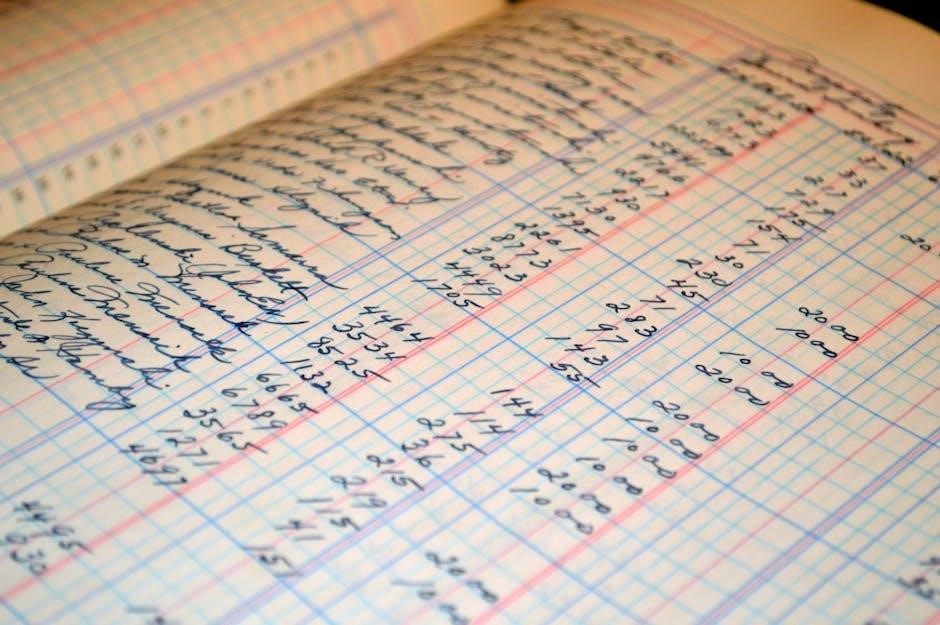F to C Chart PDF: An Overview
F to C chart PDFs offer a quick reference for temperature conversions, vital in diverse fields․ These documents simplify switching between Fahrenheit and Celsius scales, aiding in practical applications․
Understanding Temperature Scales
Temperature scales are standardized ways to measure hotness or coldness․ Fahrenheit (°F) and Celsius (°C) are the most commonly used scales globally, though Kelvin (K) is prevalent in scientific contexts․ Fahrenheit, developed by Daniel Gabriel Fahrenheit, sets the freezing point of water at 32°F and the boiling point at 212°F․ Celsius, part of the metric system, defines 0°C as the freezing point and 100°C as the boiling point of water․
Understanding the differences is crucial when working with data from various sources․ An F to C chart PDF facilitates this understanding by providing a direct visual conversion․ The relationship isn’t linear; a degree Fahrenheit represents a smaller temperature difference than a degree Celsius․ Accurate conversion is essential in fields like cooking, weather, and scientific research․
What is an F to C Chart?
An F to C chart is a table or visual guide designed to quickly convert temperatures between the Fahrenheit and Celsius scales․ These charts typically list a range of Fahrenheit temperatures alongside their corresponding Celsius equivalents․ They can be presented in various formats, including simple tables, graphs, or even more complex diagrams․
An F to C chart PDF is simply a digital version of this chart, saved in the Portable Document Format․ This format ensures the chart appears consistently across different devices and operating systems․ PDFs are easily shareable and printable, making them a convenient tool for anyone needing frequent temperature conversions․ They eliminate the need for manual calculations or online converters․
Why Use a PDF Format?
Choosing a PDF format for an F to C chart offers several key advantages․ PDFs ensure universal compatibility, displaying consistently on any device – computers, tablets, or smartphones – regardless of the operating system․ This eliminates formatting issues common with other file types․

Furthermore, PDFs are easily shareable via email or online platforms, making distribution simple․ They also preserve the chart’s original layout and design, preventing accidental alterations․ A PDF F to C chart is readily printable, providing a physical copy for offline use․ The compact file size of PDFs makes them efficient to store and transmit, and they often require minimal bandwidth․

Creating Your Own F to C Chart
Building a custom F to C chart empowers personalized temperature conversions․ Utilizing the conversion formula and a table structure provides tailored utility․
Basic Formula: Converting Fahrenheit to Celsius
The cornerstone of any F to C conversion is the fundamental formula: °C = (°F ⎼ 32) × 5/9․ This equation allows for precise temperature adjustments between the two scales․ Understanding this formula is crucial when constructing your own chart, ensuring accuracy in every conversion․ It’s a simple yet powerful tool for anyone needing to translate temperatures regularly․
Essentially, you subtract 32 from the Fahrenheit temperature, then multiply the result by 5․ Finally, divide that product by 9 to obtain the equivalent Celsius temperature․ This process is consistently applied when populating an F to C chart, whether created manually or using digital tools․ Mastering this formula unlocks the ability to quickly and reliably convert temperatures as needed․

Building a Table for Common Temperatures
Creating a practical F to C chart involves listing frequently encountered temperatures․ Begin with increments of 10°F (or 5°C) for broader coverage, then refine with smaller steps around key values like freezing and boiling points․ A well-structured table enhances readability and quick lookups․
Consider including temperatures relevant to daily life – typical room temperature, common cooking temperatures, and average weather conditions․ Organize the table with Fahrenheit in one column and the corresponding Celsius values in another․ This clear presentation facilitates easy conversion․ Utilizing spreadsheet software can streamline the process, automating calculations and formatting for a professional-looking chart․ Remember to double-check calculations for accuracy!
Utilizing Online Conversion Tools
While F to C chart PDFs are useful, numerous online conversion tools offer instant, precise results․ These tools eliminate manual calculations and potential errors, providing convenience and speed․ Many websites and apps feature dedicated Fahrenheit to Celsius converters, often with additional functionalities like bulk conversion or temperature range input․
These digital tools are particularly helpful when needing conversions outside the scope of a standard chart․ They can handle decimal values and provide highly accurate results․ However, it’s crucial to use reputable converters to ensure reliability․ Cross-referencing results with a known conversion (like water’s freezing point) can verify accuracy․ Online tools complement PDF charts, offering flexibility and precision․

Key Temperatures and Their Conversions
F to C chart PDFs frequently highlight crucial temperatures like water’s freezing and boiling points, and normal human body temperature for quick reference․

Freezing Point of Water
F to C chart PDFs consistently showcase the freezing point of water as a fundamental conversion benchmark․ This temperature, 32°F, is universally recognized and serves as a crucial point of reference for many applications; Converting this to Celsius yields 0°C, a value equally important in scientific and everyday contexts․
The accuracy of an F to C chart PDF can be quickly verified by confirming this conversion․ Charts designed for practical use will prominently display both values, ensuring users can easily correlate the two scales․ Understanding this conversion is essential in fields like meteorology, cooking, and various scientific experiments where precise temperature control is paramount․ A reliable PDF will clearly indicate this key temperature for immediate access․
Furthermore, the freezing point of water is often used as a calibration point for thermometers and other temperature-measuring devices, reinforcing its significance within temperature conversion charts․
Boiling Point of Water
A comprehensive F to C chart PDF invariably includes the boiling point of water as a critical conversion point․ At standard atmospheric pressure, water boils at 212°F․ This value, when converted to Celsius, equates to 100°C – a cornerstone of temperature measurement and scientific calculations․ The presence of both values confirms the chart’s accuracy and usability․
F to C chart PDFs designed for practical application often highlight this conversion, aiding users in quickly understanding temperature differences․ This is particularly useful in cooking, where recipes may utilize either Fahrenheit or Celsius․ Accurate charts will clearly display both scales, eliminating confusion and ensuring precise results․
The boiling point of water also serves as a reference point for calibrating equipment and understanding phase transitions, solidifying its importance within temperature conversion resources․
Normal Human Body Temperature
A reliable F to C chart PDF will prominently feature the conversion for normal human body temperature․ Generally accepted as 98․6°F, this value is crucial for medical assessments and understanding physiological responses․ Converting this to Celsius yields approximately 37°C, a vital benchmark for health professionals and individuals alike․
F to C chart PDFs intended for healthcare or personal use prioritize this conversion due to its significance in identifying fevers or hypothermia․ Accurate charts will present both Fahrenheit and Celsius readings, facilitating quick and informed decisions regarding health status․
Understanding this conversion is essential for interpreting medical literature and communicating effectively with healthcare providers globally, where Celsius is the standard․

Finding and Downloading F to C Chart PDFs
F to C chart PDFs are readily available online through educational websites, conversion tools, and document repositories, offering convenient access for users․
Reliable Sources for PDF Charts
Locating trustworthy F to C chart PDFs requires careful consideration of the source․ Reputable educational institutions and scientific organizations frequently provide accurate and well-formatted charts․ Government websites, particularly those related to meteorology or standards, are also excellent resources․
Conversion factor websites often host downloadable PDFs as supplementary materials․ However, always verify the chart’s accuracy against known conversion points, like the freezing and boiling points of water․ Avoid downloading from unfamiliar or unverified websites, as these may contain errors or even malicious software․ Look for charts that clearly state their source and any revision dates․ Prioritize sources with a strong reputation for providing reliable scientific or technical information․ Cross-referencing with multiple sources is a good practice to ensure accuracy․
Checking PDF Chart Accuracy
Verifying the accuracy of an F to C chart PDF is crucial before relying on its conversions․ Begin by testing known values: 32°F should convert to 0°C, and 212°F to 100°C․ Check several other common temperatures – normal body temperature (98․6°F) and a typical room temperature (72°F) are good starting points․
Examine the chart for consistency; conversions should follow the established formula; Look for any obvious errors in the table’s values or formatting․ If the PDF includes a source, investigate that source’s credibility․ Be wary of charts lacking clear origins or displaying unusual formatting․ A reliable chart will provide precise and consistent conversions, ensuring accurate temperature interpretations for various applications․ Double-checking is always recommended, especially in critical scenarios․
Printing and Using PDF Charts
Printing an F to C chart PDF is straightforward; ensure your printer settings are correct for accurate scaling and legibility․ Choose a paper size that accommodates the chart without distortion․ Once printed, consider laminating the chart for durability, especially in environments prone to spills or frequent handling․
For practical use, keep the chart readily accessible in relevant locations – kitchens, laboratories, or weather stations․ When converting temperatures, locate the Fahrenheit value on the chart and directly read the corresponding Celsius equivalent․ Digital PDFs offer search functionality for quick lookups․ Remember to periodically review and replace older charts to ensure continued accuracy and clarity․ A well-maintained chart is a valuable tool for seamless temperature conversions․

Applications of F to C Conversion
F to C conversions are essential across cooking, weather, and scientific fields․ Charts simplify these tasks, ensuring accurate temperature readings for diverse applications and experiments․
Cooking and Baking
F to C chart PDFs are incredibly useful in the kitchen, as many recipes originate from countries using different temperature scales․ A quick conversion ensures accurate oven temperatures for baking success․ For example, a recipe calling for 350°F needs to be converted to approximately 177°C for proper results․
Using a readily available PDF chart eliminates calculation errors, preventing undercooked or overcooked dishes․ This is particularly important in baking, where precise temperatures are crucial for chemical reactions like rising and setting․ Whether adjusting a family heirloom recipe or following an international cookbook, a conversion chart provides confidence and consistency․ Furthermore, understanding the conversion allows for better judgment when recipes only provide approximate cooking times․
Weather Forecasting

F to C chart PDFs become essential when interpreting weather reports from different sources․ Global weather data often utilizes Celsius, while some regions, like the United States, primarily use Fahrenheit․ A quick reference chart facilitates understanding temperature readings regardless of the reporting scale․
For instance, a forecast of 85°F translates to roughly 29°C, helping individuals prepare appropriately for the day’s conditions․ Having a PDF chart readily accessible allows for immediate comprehension, especially when monitoring severe weather alerts․ It’s useful for travelers checking forecasts in unfamiliar locations, ensuring they pack suitable clothing․ Accurate temperature interpretation is vital for safety and comfort, and a conversion chart simplifies this process significantly․
Scientific Experiments
F to C chart PDFs are crucial in scientific settings where precise temperature control and recording are paramount․ Many experiments require temperatures to be reported in Celsius, the standard unit within the scientific community, even if initial measurements are taken in Fahrenheit․
A readily available PDF chart ensures accurate conversions, minimizing errors that could compromise experimental results․ This is particularly important in fields like chemistry and biology, where temperature significantly impacts reaction rates and biological processes․ Researchers can quickly verify conversions during data analysis and reporting․ Maintaining consistency in units is vital for reproducibility and collaboration, and a conversion chart aids in achieving this․ Accurate temperature documentation is fundamental to the scientific method․

Advanced Considerations
F to C chart PDFs may not account for nuanced temperature differences or intervals; precise calculations require the conversion formula for accuracy․
Temperature Differences and Intervals
When working with F to C chart PDFs, understanding temperature differences is crucial․ A one-degree Fahrenheit change isn’t equivalent to a one-degree Celsius change․ Charts typically display discrete values, potentially obscuring the precise interval size․ For example, the interval between each degree Celsius is larger than that of Fahrenheit․
To calculate temperature intervals accurately, utilize the conversion formula rather than relying solely on the chart’s visual representation․ This is especially important in scientific contexts where precision is paramount․ Charts are excellent for quick lookups, but for detailed analysis involving temperature ranges or changes, mathematical conversion provides a more reliable result․ Remember that a change of 1°C is equal to a change of 1․8°F․
Dealing with Negative Temperatures
F to C chart PDFs often include negative temperatures, essential for weather reports and scientific applications․ When converting from Fahrenheit to Celsius with negative values, careful attention to the formula is needed to avoid errors․ The standard conversion formula (C = (F ─ 32) × 5/9) remains valid, but the subtraction step is critical․
Some charts may visually represent negative Celsius temperatures differently, potentially causing confusion․ Always double-check the scale and ensure accurate interpretation․ When using a chart, verify that it extends to the required negative temperature range․ For precise conversions involving negative values, employing an online converter alongside the PDF chart is recommended for confirmation and accuracy․
